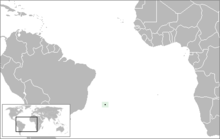Southern Trinidad Petrel
| Southern Trinidad Petrel | ||||||||||
|---|---|---|---|---|---|---|---|---|---|---|

South Trinidad Petrel painted by Louis Agassiz Fuertes |
||||||||||
| Systematics | ||||||||||
|
||||||||||
| Scientific name | ||||||||||
| Pterodroma arminjoniana | ||||||||||
| ( Giglioli & Salvadori , 1869) |
The Trindade Petrel ( Pterodroma arminjoniana ) is a species of bird in the family of the petrels . There are two subspecies. The breeding area of the species is limited to the Trindade and Martim Vaz archipelago about 1150 kilometers off the east coast of Brazil. The IUCN classifies the South Trinidad petrel as endangered ( vulnerable ) and roughly estimates the population at between 1,100 and 15,000 sexually mature individuals.
features
The South Trinidad petrel reaches a body length of 34 to 39 centimeters. The wingspan is 88 to 102 centimeters and the weight is an average of 318 grams. There is no noticeable sexual dimorphism .
The plumage is individually colored very variably. A general distinction is made between a light and a dark color morph; however, there are individuals who have features of both morphs. Partial albinism also occurs in some individuals .
The light colored morph has a predominantly ash-brown head with a whitish spot on the lateral base of the beak, small white speckles on the forehead, a white chin and a white throat. The wings are dark gray-brown on top. The back is dark ash brown, the individual feathers are lined with light. The control springs are black-brown. The fore neck, the sides of the chest and the flanks are finely speckled gray and white, the rest of the body underside is white. Only the lower tail-coverts have blackish tips. The legs are whitish pink, the webbed feet are black. The head and body of the dark morph are brown. The legs of this morph are also black. Common to both morphs is the black beak and the brown iris .
There are several species of petrels that the Southern Trinidad petrel can be confused with. The resemblance to the Kermadec petrel , which also has a light and dark color morph, is very pronounced . The light color morph of the southern Trinidad petrel also has a resemblance to the phoenix petrel and magenta petrel .
Distribution area
The breeding area of the southern Trinidad petrel is limited to the Trindade and Martim Vaz archipelago about 1150 kilometers off the east coast of Brazil. Otherwise it is mainly observed over the tropical and subtropical seas of the southern hemisphere and occurs in the Pacific as well as in the Atlantic and Indian Oceans. Sightings off the coast of South Africa have not yet been verified, which may mean that there are either previously unknown breeding colonies or that the species is migrating further outside of the breeding season than previously assumed.
Way of life
The way of life of the southern Trinidad petrel is largely unexplored. All that is known is that its food spectrum also includes cephalopods . On Trindade the birds breed in niches on the cliffs.
Hazards and protective measures
As a ground-breeder, the South Trinidad petrel on Trindade was endangered by domestic pigs and cats introduced as well as by the stalking of humans since the beginning of the 18th century. This has resulted in it only breeding on inaccessible cliffs. The goats that were also introduced and that led to extensive deforestation on this island were all killed by 1970. However, it is not known what influence these had on the choice of nesting site for southern Trinidad petrels. Martim Vaz , on the other hand, was never inhabited, so that, according to current knowledge, there are no introduced mammals there. However, this island was previously used occasionally during maneuvers by the Brazilian Navy as a target for target practice.
supporting documents
literature
- PJ Higgins (Ed.): Handbook of Australian, New Zealand & Antarctic Birds , Volume 1, Ratites to Ducks, Oxford University Press, Oxford 1990, ISBN 0195530683
Web links
- Pterodroma arminjoniana inthe IUCN Red List of Threatened Species 2010.4. Posted by: BirdLife International, 2010. Retrieved June 1, 2011 ..
- BirdLife Factsheet on the Trinidad Petrel
Single receipts
- ↑ BirdLife Factsheet on the Trinidad Petrel , accessed May 28, 2011
- ^ Higgins, p. 440
- ^ Higgins, p. 441
- ↑ BirdLife Factsheet on the Southern Trinidad Petrel , accessed May 28, 2011
- ^ Higgins, p. 441
